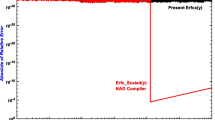Abstract
A new kind of integral formulas for \({\bar{P}_{n,m} (x)}\) is derived from the addition theorem about the Legendre Functions when n − m is an even number. Based on the newly introduced integral formulas, the fully normalized associated Legendre functions can be directly computed without using any recursion methods that currently are often used in the computations. In addition, some arithmetic examples are computed with the increasing degree recursion and the integral methods introduced in the paper respectively, in order to compare the precisions and run-times of these two methods in computing the fully normalized associated Legendre functions. The results indicate that the precisions of the integral methods are almost consistent for variant x in computing \({\bar{P}_{n,m} (x)}\), i.e., the precisions are independent of the choice of x on the interval [0,1]. In contrast, the precisions of the increasing degree recursion change with different values on the interval [0,1], particularly, when x tends to 1, the errors of computing \({\bar{P}_{n,m} (x)}\) by the increasing degree recursion become unacceptable when the degree becomes larger and larger. On the other hand, the integral methods cost more run-time than the increasing degree recursion. Hence, it is suggested that combinations of the integral method and the increasing degree recursion can be adopted, that is, the integral methods can be used as a replacement for the recursive initials when the recursion method become divergent.
Similar content being viewed by others
References
Abramowitz M, Stegun I (1964) Handbook of Mathematical Functions, Nat Bur Stds Appl Math Series, vol. 55. Washington, DC
Drake JB, Worley P, D’Azevedo E (2008) Algorithm 888: spherical harmonic transform algorithms. Acm Trans Math Softw 35: 1–23
Fantino E, Casotto S (2009) Methods of harmonic synthesis for global geopotential models and their first-, second- and third-order gradients. J Geod 83(59): 5–620
Hobson (1931) The theory of spherical and ellipsoidal harmonics. Cambridge University Press (in press, 1965)
Holmes SA, Featherstone WE (2002) A unified approach to Clenshaw summation and the recursive computationn of very high degree and order normalised associated Legendre functions. J Geod 76: 279–299
Jekeli C, Lee JK, Kwon JH (2007) On the computation and approximation of ultra-high degree spherical harmonic series. J Geod 81: 603–615
Koop R, Stelpstra D (1989) On the computation of the gravitational potential and its first and second order derivatives. Manuscr Geod 14: 373–382
Wittwer T, Klee R, Seitz K, Heck R (2008) Ultra-high degree spherical harmonic analysis and synthesis using extended-range arithmetic. J Geod 82: 223–229
Author information
Authors and Affiliations
Corresponding author
Additional information
This work is funded by the National Natural Science foundation of China (No. 41074015).
Rights and permissions
About this article
Cite this article
Yu, J., Wan, X. & Zeng, Y. The integral formulas of the associated Legendre functions. J Geod 86, 467–473 (2012). https://doi.org/10.1007/s00190-011-0529-0
Received:
Accepted:
Published:
Issue Date:
DOI: https://doi.org/10.1007/s00190-011-0529-0



